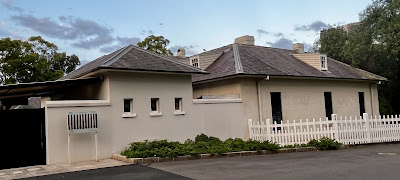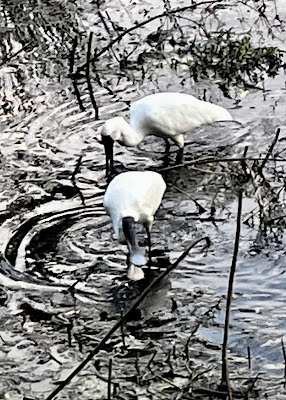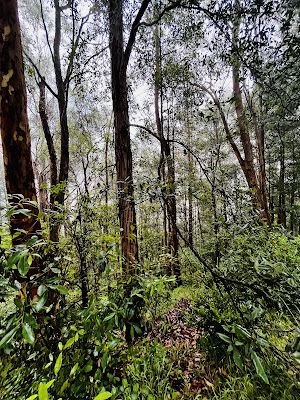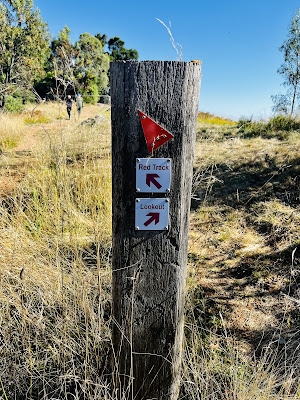A hellish week of work travelling around the state calls for some self-compassion. This mainly involves food, friendship and walks. Exhibit A: dinner at Kumiho in Parramatta.
 |
| Seaweed Salad |
 |
| Stir Fried Udon with Pork Belly Slice |
 |
| Steamed Chicken Dumplings |
Exhibit B: a walk in Parramatta Park. Situated on the traditional lands of the Burramatta Darug, World Heritage listed Old Government House is the oldest surviving public building in Australia. Built by convicts, it was commenced in 1799 by Governor Hunter and enlarged by Governor Macquarie in 1815. It served as the country residence for the first ten Governors of Australia.
The park was used as a government farm. 'Plentiful and luxuriant' was how Judge Advocate David Collins described the Government Farm on this site where, under the management of Henry Edward Dodd, the first successful crops were grown in the colony.
Dodd, Governor Phillip's trusted retainer and one of the few experienced farmers in the colony, planted wheat and barley in June and July 1789, as well as corn, oats and a small quantity of flax. The first harvest was made in December 1789 and by June the following year Captain Watkin Tench estimated an are of about 200 acres was cleared and cultivated, and Governor Phillip again reported flourishing crops.
I walked along the river past trees full of bats.
"The public of Parramatta have one of the grandest heritages in the park, and no other park in the Commonwealth can compare with it in historic associations..." - Cumberland Argus and Fruitgrowers Advocate, 21 January 1905
The Dairy Cottage was built between 1976 and 1800 by ex-convict George Salter. The Cottage was purchased by Governor Lachlan Macquarie in 1813. The surrounding farm was converted into a dairy and amalgamated into the Governor's Domain. In 1858, the Governor's Domain was gazetted as a public park.
The park is indeed pleasant, and well frequented from the folk walking round the paths, to the groups of old men sat in the shelters chatting or the families picnicking on the grass and watching the waterbirds on the ponds.
The cleared strip of land and the memorial is on account of this being the site of the landing of one of the earliest and longest flights in New South Wales when William Ewart 'Billy' Hart flew from Penrith on 3 November 1911. A nearby information panel announces,
"In 1911 the British Colonial Aeroplane Company introduced the Bristol Boxkite into Australia, and Billy Hart was an immediate enthusiast. The young dentist, from a wealthy Parramatta family, had a keen interest in mechanics and purchased his own Boxkite for £1,300. He had some lessons, but crashed the biplane early on and had to rebuild his aircraft from the debris in his father's Parramatta workshop.
Billy became a local sensation as he tinkered with the machine for months on the ground and then taught himself to fly. Hart made his first solo flights in Penrith and on the 3rd of November he undertook the historic long distance flight from Penrith to land in Parramatta Park.
In his first cross country flight in New South Wales, Hart astonished the community by travelling a distance of 18 miles (29km) in just over half an hour, and his aircraft reached an altitude of 3,000 feet (914m)
This flight was acclaimed as a remarkable performance, both by the aviation world and by the startled locals who watched him land on the Parramatta Park cricket fields."
I did notice that the memorial states that the flight was 18 miles and took 19 minutes, so there is a slight discrepancy in the figures, but it seems like it was quite the achievement regardless.
 |
| The Boer War Memorial |
"This memorial commemorates the Parramatta Lancers' contribution to the 1899-1902 War fought by the British Empire against the Boer Republic. The Volunteer Lancers were the first Australian troops to arrive in South Africa and 'went to show the world that the colonies were at one with the mother country'.
This Memorial was dedicated in April 1904 and incorporates columns and stone recycled from the Parramatta Court House, which was designed by Mortimer Lewis in 1837 and stood on the corner of George and Church Streets until it was demolished in 1903."
 |
| Macquarie Street Gatehouse |
Exhibit C: dinner at Neelam Indian Restaurant
 |
| Dehli Chat |
Exhibit D: Morning walk in Hornsby.
 |
| Disused tennis court |
 |
| Man, Time and the Environment |
The Hornsby Water Clock, titled Man, Time and the Environment, is a piece of kinetic sculpture, a decorative fountain and a functional clock, engineered by Victor Cusack and constructed of bronze, stainless steel and glass by Victor and his foundry floor manager, Rex Feakes.
It is a combination of three water-powered clocks: a 4th-century BC Greek clepsydra; an 11th-century Chinese water wheel clock and a 17th-century Swiss pendulum clock - plus a 17-note bronze carillon to ring the hour based on a 250-year-old design found in an English church. The whole assembly is mounted on a floating pontoon that rotates every 12 hours giving a fourth time indicator as a pointer sweeps past Roman numerals placed in the water around the fountain's perimeter.
 |
Swiss pendulum clock
|
 |
| Chinese water wheel clock |
This clock uses 20 counterweighted buckets that are free to swing and are mounted around the edge of a wheel 2.3m (7.5ft) in diameter. Water supplied from a meniscus-full tank runs into a bucket at a constant rate until the weight of water in the bucket is sufficient to overcome the counterweight allowing the bucket to tip over spilling its contents. As it falls, it trips a lever connected by a cable to a catch on top of the water wheel which is released to allow the wheel to rotate. However, by the time it has moved on, the catch has returned to its position locking the wheel in place so that the next empty bucket is now under the water flow to repeat the cycle. The design is based on one by Su Song who built a clock as part of an observatory tower in the period 1088-1092.
 |
| Carillon |
The carillon has 17 tubes of cast bell-bronze that chime automatically on the hour, or they can be played manually.
 |
| Greek Clepsydra Clock |
In this type of clock, water is run into a stationary vessel from a tank which is kept meniscus-full. Since the depth of the water in the supply tank is constant, water is released at a constant rate; the depth of water in the receiving vessel is a measure of time. In this example, two tubes on bearings are arranged so that they overbalance when full, thereby dumping their contents into the pond and returning to vertical under the influence of a counterweight at which point the cycle starts over. The counterweight is in the shape of a ram's head, while the top of each tube is decorated with the head of a Hermaphrodite.
 |
| Another not-quite-so-impressive fountain |
Exhibit E: Coming home - always reassuring to know I am going to see Him Outdoors and the kittens again soon, and a reminder that I live in a pretty good landscape too.
Exhibit F: Friends. Back home I attended the Ovations Awards Celebration Dinner. I am the head of the theatre judging panel and I went with good friend and fellow judge, Purple Lady. Recognising the arts and the powerful part it plays in community life is a jolly good thing.
Exhibit G: Walk (and trigbagging) followed by breakfast with friends. A walk in Red Hill Nature reserve resulting in three trig points! Davidson was obvious, and the other two (Red Hill East and Red Hill Ecce) less so.
 |
| Davidson Trig |
 |
| The Luminosity and Purple Lady at the lookout |
 |
| Round about Red Hill East |
 |
| Red Hill Ecce |
Breakfast at Beess & Co Café featured hot cakes, French toast and (of course) bacon.
 |
| Purple Lady with French toast |
 |
| The Luminosity with Blueberry Ricotta Hot Cakes |
 |
| My Breakfast Rosti (with a side of bacon) |




































































No comments:
Post a Comment